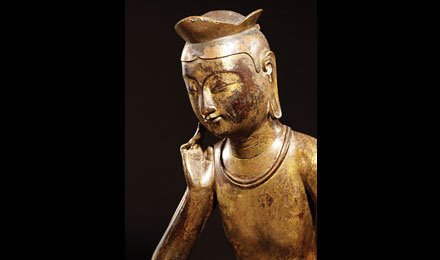The Smile of Buddha
dal 8/10/2008 al 17/1/2009
Segnalato da
8/10/2008
The Smile of Buddha
Bozar - Centre for Fine Arts, Bruxelles
1600 Years of Buddhist Art in Korea. Countless works of art and everyday objects bear witness to the influence of Buddhism. Buddhist motifs and images have been widespread since the 5th century. Among the treasures on display will be a number of national treasures from the National Museum in Seoul, including the gilded bronze Maitreya figure from the early 7th century, and a selection of the grandest paintings of the Goryeo period.

Curator: Jan Van Alphen
Within the framework of the festival Made in Korea, in the autumn of 2008, the
Centre for Fine Arts presents The Smile of Buddha – 1600 years of Buddhist art in
Korea. For the first time this exposition brings 130 extraordinary Korean pieces of
art to Brussels and tells the history of development of Buddhism.
Through its particular geographic location between China and Japan, Korea served as
an intermediary of culture, economy and religion between both countries. Thus in the
4th century Buddhism arrived via China in Korea, where it was influenced by native
religions like shamanism. Later these Korean Buddhist teachings by their part had an
impact on Japan.
Although Korea had a lot of exchange wit hits neighbouring countries, it developed a
culture entirely of its own. Buddhism occupies a central position within the Korean
society: numerous works of art and daily appliances give evidence for the Buddhist
influence. The sculptures, paintings, ceramics and architecture in Korea, inspired
by Buddhism, also have their own specific and unique characteristics.
The exposition is structured chronologically and spans the period form the 5th
century until the 20th century. The Smile of Buddha contains some of the most
refined and richest art treasures Korea ever produced: Buddha and Bodhisattva
depictions out of different materials (bronze, gilt bronze, iron and stone) and in
several formats (going from little votive statues to more than life-sized
sculptures) temple ornaments in terra cotta (decorative roof tiles, relieved paving
tiles) implements (stone urns, dishes, teapots) with Buddhist motives, golden and
bronze reliquaries out of pagodas with the original content, bronze temple bells and
ritual objects, Buddhist writings (Sutras), national treasures from the National
Museum of Seoul, a selection of the finest paintings Koryo-period, a golden kings
crown and a golden belt from the 6th century out of royal tombs…
The exhibition ends with some extraordinary pencil drawings of the contemporary
“Maestro of Korean Art” Park Dae-Sung.
Next to The Smile of Buddha, the main exhibition of the Korea Festival, the Centre
for Fine Arts presents contemporary art from four leading Korean artists.
The Hundred and Eight Torments of Mankind from Nam June Paik
Ever since the Sixties Nam June Paik has been a pioneer in video art. At first, this
was within the Fluxus movement; later, his visual approach concentrated on the new
media of the time - television - which he used as a veritable sculpted material. His
innovative approach gave birth to video art, now widely used by artists all over the
world.
Lotus: Zone of Zero 2008 from Kimsooja
With his multimedia installation Lotus: Zone of Zero 2008 Kimsooja brings an ode to
peace. This talent out of the current Korean art scene is an atypical figure at the
crossroads between photography, performance, video and installation. She distributes
her lotus flower lanterns against a background of Tibetan, Gregorian and Arabic
hymns.
Sacred wood - Timeless photography from Bae, Bien-U
Communion with Nature is the leitmotiv of Bae, Bien-U's photographic work. With
Sacred wood - Timeless photography he wants to reflect the desire of the Korean
people to live in harmony with their environment.
111 bowls from Young-Jae Lee
Young-Jae Lee creates a unique installation by grouping simple ceramic bowls: every
bowl speaks for itself and by uniting them she creates a peaceful dialogue.
Scenographer: Lee Preedy
Press opening 9th of October at 11am
Bozar Centre for Fine Arts
Rue Ravensteinstraat 23 - Brussels



